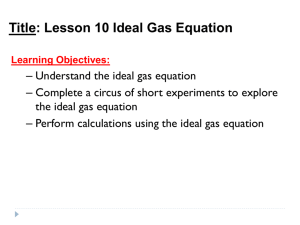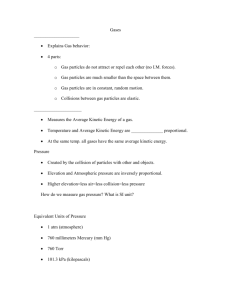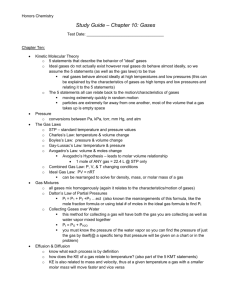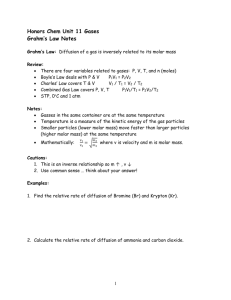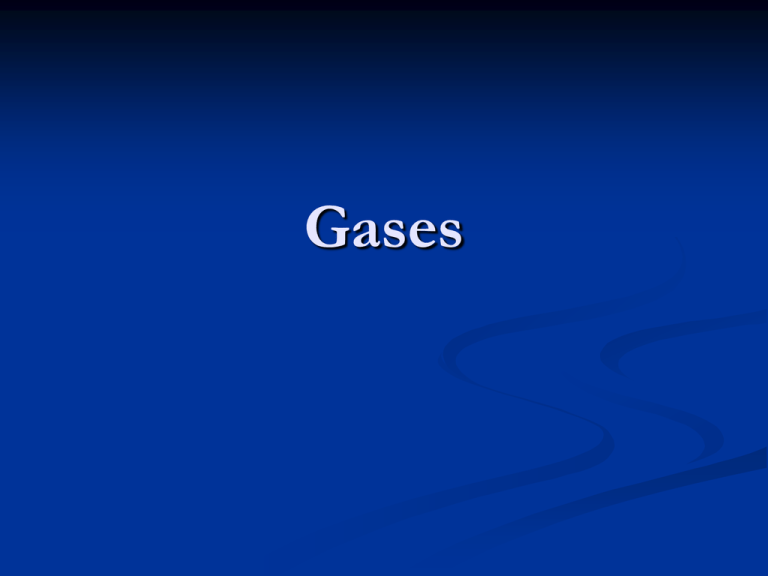
Gases
Properties of Gases
Gases uniformly fill any container, are easily
compressed, typically have low densities (in
g/liter rather than g/mL) and are infinitely
miscible. Gases also exert pressure.
The volume, pressure and temperature of a
gas are related. If one heats a gas, its volume
will either expand, or its pressure will increase.
Measurement of Pressure
The pressure of most gases is often
measured relative to atmospheric pressure.
Atmospheric pressure is the pressure due to
the atmosphere pushing down on the earth’s
surface. Atmospheric pressure is measured
using a barometer.
Barometric Pressure
The pressure of the
atmosphere varies with
weather patterns and
altitude. A standard
atmosphere, the average
atmospheric pressure at sea
level, is defined as exactly
760 mmHg or 760 torr.
Measurement of Pressure
A manometer is
used to
measure the
pressure of a
confined gas
relative to
atmospheric
pressure.
Units of Pressure
Although there are many units for pressure
(lbs/in2, pascals, inches of Hg), the units used by
chemists are typically atmospheres and mmHg
or torr.
The Gas Laws
Gases are unique in that gases of different
compounds or elements tend to behave in the
same way under the same conditions of
temperature, volume and pressure.
Early scientists studied the behavior of gases
and developed simple mathematical
relationships, called gas laws, that describe the
behavior of most gases.
The Gas Laws
The relationships are called ideal gas laws,
since under “ideal conditions” (high
temperature and low pressure), almost all gases
behave in the same way.
Typical laboratory conditions of 1 atm
pressure and a temperature of 25oC (298K)
usually result in ideal or near-ideal behavior.
The Gas Laws – Boyle’s Law
Robert Boyle (1627-1691) studied the
relationship between the volume of a trapped
sample of gas and its pressure.
Using a “J” tube filled with mercury, Boyle
was able to calculate the volume of the gas
trapped in the tube, along with its pressure.
The Gas Laws – Boyle’s Law
By adding more
mercury to the tube,
he could change the
pressure of the gas
and determine its new
volume.
Boyle’s Law
He found that the volume of the gas is
inversely proportional to its pressure. That is, if
the pressure is doubled, the volume decreases by
a factor of two. Mathematically, this
relationship can be expressed as:
Vα(1/P)
or
PV=constant
Boyle’s Law
The experimental results can be graphed as:
Boyle’s Law
Copyright © Houghton Mifflin Company. All rights reserved.
Boyle’s Law
Boyle’s law can be used when a gas sample
undergoes a change in pressure, and the
temperature is held constant. The law can be
written as:
P1V1= P2V2
where the “1” indicates initial conditions, and
the “2” indicates final conditions.
The Gas Laws – Charles’ and
Gay-Lussac’s Law
Jaques Charles (1746-1823) was a physicist
and a balloonist. He and Joseph Gay-Lussac
(1778-1850) studied the relationship between the
temperature of a sample of gas and its volume
(at constant pressure).
They found a linear relationship between the
increase in the volume of the gas and the
temperature in oC.
Charles’ Law
Charles’ Law
Charles & GayLussac studied
the behavior of
many samples
of different
gases. All data
converged at a
temperature of
-273.15oC.
The Kelvin Temperature Scale
Lord Kelvin, in 1848, identified -273.15oC as
absolute zero, theoretically the lowest attainable
temperature.
For all gas law equations involving
temperature, the Kelvin scale is used.
Temperature in Kelvins = oC + 273.15
Charles’ Law (1787)
Charles found that the volume of a gas at
constant pressure is directly proportional to the
temperature in kelvins.
VαT
or
(V/T) = constant
Charles’ Law
If a specific sample of a gas undergoes a
temperature change at constant pressure,
Charles’ Law can be expressed as:
(V1/T1) = (V2/T2)
where the “1” indicates initial conditions and
the “2” indicates final conditions
The Gas Laws – Avogadro’s Law
In 1811 Avogadro postulated that equal
volumes of gases at the same temperature and
pressure contain the same number of particles.
Avogadro’s Law can be expressed as:
Vαn
or
V=constant(n)
where n is the number of moles, and T and P
are held constant
Problem
0.50L of nitrogen gas is reacted with hydrogen
gas to produce gaseous ammonia. What
volume of hydrogen is needed, and what
volume of ammonia will be produced?
Assume constant P and T.
1. Write the balanced chemical reaction.
N2(g) + 3H2(g) 2 NH3(g)
Problem
N2(g) + 3H2(g) 2 NH3(g)
0.50L
?L
?L
Apply Avogadro’s Law. Since equal volumes
of gases contain an equal number of particles,
0.50L of N2 requires 3 times that volume of
hydrogen.
0.50L N2 (3 L H2/1 L N2) =1.5 L H2 needed
Problem
N2(g) + 3H2(g) 2 NH3(g)
0.50L
?L
?L
Likewise, 0.50L of N2 produces twice that
volume of ammonia.
0.50L N2 (2 L NH3/1 L N2) =1.0 L NH3 produced
The Combined Ideal Gas Law
The previous relationships can be combined
into a single equation:
PV=constant
(V/T) = constant
V=constant(n)
The Combined Ideal Gas Law
The previous relationships can be combined
into a single equation:
PV=constant
(V/T) = constant
V=constant (n)
PV
T
= constant (n)
The Combined Ideal Gas Law
PV = constant (n)
T
The equation can be rearranged to:
The equation is usually written as:
PV=nRT
The Ideal Gas Law
PV=nRT
where R =0.08206 L-atm/mol-K
Gases are unique in that a single equation
applies to all gases, and allows you to calculate
one of the variables (P,V, n or T) if you know
the other three.
Problem
7.8 L of NH3 is collected at 20oC and a pressure
of 795 torr. How many grams of ammonia were
produced?
PV=nRT
V=7.8L; T=20oC + 273K=293K;
P=795 torr(1 atm/760 torr)=1.05 atm
PV
n = RT = (1.05 atm) ( 7.8L )
(.0821 L-atm/mol-K)(293K)
Problem
n =0.34 moles NH3
mass of NH3 = (0.34 mol NH3)(17.0 g NH3/ mol
NH3)
= 5.8 g NH3
Standard Temperature and Pressure
In order to compare gaseous volumes or the
number of moles, the gases must be at the same
temperature and pressure. A standard for
temperature and pressure (STP) has been
established as:
standard temperature = 0oC = 273.15K
standard pressure = 1 atm (exactly) = 760 mmHg
Molar Volume at STP
Using the ideal gas law and standard temperature
and pressure, a mole of any gas at STP occupies
a volume of 22.42 L.
PV=nRT
V=(nRT)/P
V= (1 mol)(0.08206 L-atm/mol-K)(273.15K)
1 atm
Molar Volume @STP=22.42 L
Problem
Potassium chlorate decomposes when heated to
form potassium chloride and oxygen gas. If 1.08
g of KClO3 is decomposed, what volume of
oxygen will be produced at STP?
1. Write the balanced chemical equation.
2 KClO3(s)
Δ 2 KCl(s) + 3 O2(g)
Problem
2. Map out the problem.
2KClO3(s)
2KCl(s) + 3 O2(g)
Δ
1.08g
? L@STP
grams KClO3 moles KClO3 moles O2 L O2
molar mass KClO3
coefficients
molar volume
Problem
3. Solve the problem.
2KClO3(s) 2KCl(s) + 3 O2(g)
1.08g
? L@STP
grams KClO3 moles KClO3 moles O2 L O2
molar mass KClO3
coefficients
molar volume
(1.08g KClO3)(1 molKClO3/122.6 g KClO3)(3 mol O2/2 mol KClO3) =
=0.0132 mol O2
Problem
moles of O2 @ STP = 0.0132 mol
volume at STP = (0.0132 mol)(22.42 L/mol) =
= 0.296 liters
This volume represents the theoretical yield at
STP.
Problem
0.296 liters = theoretical yield @STP
What is the percent yield if 0.308 L were
collected at 25oC and 725 mmHg?
To compare the two volumes, they must be
at the same temperature and pressure.
Combining Boyle’s and Charles’ laws we get:
P1V1 = P2V2
T1
T2
Applications of the Ideal Gas Law
Determination of molar mass
The molar mass of any gas can be
determined fairly easily using the gas
temperature and pressure and either its density
(δ) or sample mass and its volume.
PV = nRT
where n = sample mass/molar mass
Applications of the Ideal Gas Law
PV = nRT
where n = sample mass/molar mass
sample mass (RT)
PV = molar mass
Rearranging we obtain:
Applications of the Ideal Gas Law
molar mass = sample mass (RT)
PV
Since gas density (δ) = sample mass/volume, the
above equation becomes:
molar mass = δ RT
P
Problem: Molar Mass
A 0.9269 g sample of gas is collected in a 500.
mL vessel at 22oC and 760. mmHg. Determine
the molar mass of the gas.
Mixtures of Gases – Dalton’s
Law
John Dalton proposed his Law of Partial
Pressures in 1803:
For a mixture of gases, the total pressure
exerted is the sum of the pressures each gas
would exert if it were alone.
Ptotal = Pa + Pb + Pc + ……
Mixtures of Gases – Dalton’s
Law
Ptotal = Pa + Pb + Pc + ……
Since Pαn, the total pressure is related to the
total number of moles of gas.
Ptotal = ntotal(RT/V)
In considering a particular gas in a mixture,
we can calculate its partial pressure. We can also
calculate its concentration by using mole fractions.
Mixtures of Gases – Dalton’s
Law
The mole fraction of a gasA =XA =
(moles of the gas A)
(total number of moles of gas)
Since pressure α # of moles,
XA= (pressure of gas A)
(total pressure)
Mixtures of Gases – Dalton’s
Law
Dalton’s law is useful when a gas is collected by
bubbling it through water. The collected gas contains
water vapor along with the gas(es) of interest.
Collecting a Gas Over Water
Problem – Dalton’s Law
0.308 L of oxygen gas were collected at 25oC
and 725 mmHg by bubbling it through water,
also at 25oC . What is the amount, in moles, of
oxygen in the collected sample. The vapor
pressure of water at 25oC is 23.756 torr.
Calculate the mole fraction of oxygen in the
sample.
The Kinetic Molecular Theory
Scientists developed a theory of the structure
of gases to explain all of their properties and the
gas laws. The model is for ideal gases, and
consists of four basic assumptions or postulates.
The Kinetic Molecular Theory
1. The gas particles are small compared with the
volume occupied by the sample. The volume
occupied by the particles themselves is assumed
to be negligible.
The Kinetic Molecular Theory
This assumption explains the high
compressibility of gases. Some of the vast
empty space between the particles is removed
upon compression.
The Kinetic Molecular Theory
2. The particles are in constant random motion.
The collision of particles with the walls of the
container cause the pressure exerted by the gas.
This assumption explains Boyle’s law, that
the pressure increases when the volume of a gas
is decreased.
Boyle’s Law – Molecular View
Kinetic Molecular Theory
3. All collisions are elastic. That is, they involve no
loss of kinetic energy to friction.
This explains why a gas in a sealed container
will exert a constant pressure as long as the
temperature doesn’t change.
Kinetic Molecular Theory
4. The particles behave independently. There are
no attractive nor repulsive forces between the
particles.
This assumption explains Dalton’s Law of
Partial Pressures- each gas exerts a pressure as if
it were alone in the container. It also explains
why all gases, regardless of structure behave
similarly under the same conditions.
Kinetic Molecular Theory
5. The average kinetic energy of a large sample of
gas particles is directly proportional to the
temperature (in Kelvins) of the gas.
This explains Charles’ law – the relationship
between volume and temperature.
Charles’ Law – Molecular View
The Motion of Gases
A large collection of gas particles at a given
temperature contains particles with the same
average kinetic energy. Some particles may be
moving faster, some slower. In addition, the
direction and velocity of particles will change as
they collide with each other.
The Motion of Gases
The Motion of Gases
The root mean square velocity (urms) of gas
particles can be calculated using the following
equation:
urms =(3RT/M)1/2
where M is molar mass
T is temperature in Kelvins
and R = 8.3145 J/K-mol
(a Joule = 1 kg-m2/s2)
The Motion of Gases
urms =(3RT/M)1/2
This equation shows
that the average velocity
of gaseous particles
increases with increasing
temperature.
Note that even at
lower temperatures, there
is a range of velocities
for the particles.
The motion of Gases
urms =(3RT/M)1/2
The above formula shows that, at the same
temperature, heavier gas particles on average
travel at a slower velocity than lighter particles.
This difference in velocity can be used to
separate gas particles of different molar masses.
The motion of Gases
urms =(3RT/M)1/2
The above
formula shows that,
at the same
temperature, heavier
gas particles on
average travel at a
slower velocity than
lighter particles.
The Motion of Gases
Gas particles exhibit two types of motion.
Effusion is the passage of gas particles through a
tiny opening or hole into an evacuated chamber.
Effusion
Diffusion
Diffusion refers to the spontaneous mixing of gaseous
particles.
Effusion & Diffusion
For either type of motion, the rate is
inversely proportional to the molar mass of the
gas. If two gases effuse or diffuse at the same
temperature,
rate of gas A
rate of gas B
=
√MB
√MA
Non-Ideal Behavior
Real gases exhibit or nearly exhibit the ideal
behavior under certain conditions. No real gas
behaves ideally under all conditions.
Typically, non-ideal behavior is seen when
gases are highly compressed (at low T and high
P). Under these conditions, some of the
postulates of the kinetic molecular theory are no
longer true.
Non-Ideal Behavior
Note that the deviations from ideal behavior are
slight at higher temperatures and lower
pressures.
Non-Ideal Behavior
Real gas particles have a non-negligible
volume, especially when highly compressed.
That is, the volume occupied by the particles
themselves must be accounted for.
The Effect of Particle Volume
van der Waal’s Equation
One corrected gas law, van der Waals
equation, corrects for the excluded volume by
subtracting a correction, nb, from the volume of
the container. n is the number of moles, and b is
experimentally determined for the particular gas.
Applying the correction to the ideal gas law,
PV=nRT
becomes
P(V-nb) = nRT
van der Waal’s Equation
An additional correction is made to the
pressure term. Real gas particles are slightly
attracted to each other, and as a result exert
slightly less pressure than expected when the
particles are near each other.
Intermolecular Forces
van der Waal’s Equation
The pressure term in the ideal gas law is
corrected by a factor of a(n/V)2. Where a is
experimentally determined for each gas.
van der Waal’s Equation
PV=nRT
becomes
(P+an2/V2)(V-nb) = nRT
There are many other corrected gas laws.
Each works well under specific conditions, and
some are easier to use than others.

